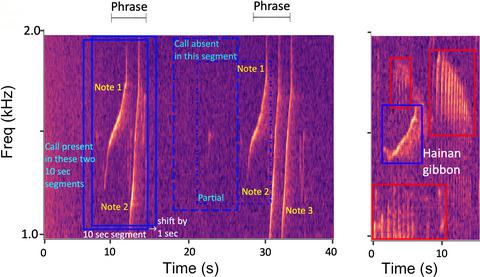当前位置:
X-MOL 学术
›
Remote Sens. Ecol. Conserv.
›
论文详情
Our official English website, www.x-mol.net, welcomes your
feedback! (Note: you will need to create a separate account there.)
Automated detection of Hainan gibbon calls for passive acoustic monitoring
Remote Sensing in Ecology and Conservation ( IF 3.9 ) Pub Date : 2021-04-08 , DOI: 10.1002/rse2.201 Emmanuel Dufourq 1, 2 , Ian Durbach 1, 3, 4 , James P. Hansford 5, 6 , Amanda Hoepfner 7 , Heidi Ma 5 , Jessica V. Bryant 8 , Christina S. Stender 9 , Wenyong Li 10 , Zhiwei Liu 10 , Qing Chen 10 , Zhaoli Zhou 10 , Samuel T. Turvey 5
Remote Sensing in Ecology and Conservation ( IF 3.9 ) Pub Date : 2021-04-08 , DOI: 10.1002/rse2.201 Emmanuel Dufourq 1, 2 , Ian Durbach 1, 3, 4 , James P. Hansford 5, 6 , Amanda Hoepfner 7 , Heidi Ma 5 , Jessica V. Bryant 8 , Christina S. Stender 9 , Wenyong Li 10 , Zhiwei Liu 10 , Qing Chen 10 , Zhaoli Zhou 10 , Samuel T. Turvey 5
Affiliation

|
Extracting species calls from passive acoustic recordings is a common preliminary step to ecological analysis. For many species, particularly those occupying noisy, acoustically variable habitats, the call extraction process continues to be largely manual, a time-consuming and increasingly unsustainable process. Deep neural networks have been shown to offer excellent performance across a range of acoustic classification applications, but are relatively underused in ecology. We describe the steps involved in developing an automated classifier for a passive acoustic monitoring project, using the identification of calls of the Hainan gibbon Nomascus hainanus, one of the world's rarest mammal species, as a case study. This includes preprocessing—selecting a temporal resolution, windowing and annotation; data augmentation; processing—choosing and fitting appropriate neural network models; and post-processing—linking model predictions to replace, or more likely facilitate, manual labelling. Our best model converted acoustic recordings into spectrogram images on the mel frequency scale, using these to train a convolutional neural network. Model predictions were highly accurate, with per-second false positive and false negative rates of 1.5% and 22.3%. Nearly all false negatives were at the fringes of calls, adjacent to segments where the call was correctly identified, so that very few calls were missed altogether. A post-processing step identifying intervals of repeated calling reduced an 8-h recording to, on average, 22 min for manual processing, and did not miss any calling bouts over 72 h of test recordings. Gibbon calling bouts were detected regularly in multi-month recordings from all selected survey points within Bawangling National Nature Reserve, Hainan. We demonstrate that passive acoustic monitoring incorporating an automated classifier represents an effective tool for remote detection of one of the world's rarest and most threatened species. Our study highlights the viability of using neural networks to automate or greatly assist the manual labelling of data collected by passive acoustic monitoring projects. We emphasize that model development and implementation be informed and guided by ecological objectives, and increase accessibility of these tools with a series of notebooks that allow users to build and deploy their own acoustic classifiers.
中文翻译:

自动检测海南长臂猿叫声进行被动声学监测
从被动声学记录中提取物种调用是生态分析的常见初步步骤。对于许多物种,尤其是那些占据嘈杂、声学可变的栖息地的物种,呼叫提取过程仍然主要是手动的,这是一个耗时且越来越不可持续的过程。深度神经网络已被证明可以在一系列声学分类应用中提供出色的性能,但在生态学中使用相对较少。我们描述了为被动声学监测项目开发自动分类器所涉及的步骤,使用海南长臂猿Nomascus hainanus的呼叫识别,世界上最稀有的哺乳动物之一,作为案例研究。这包括预处理——选择时间分辨率、窗口和注释;数据增强;处理——选择和拟合合适的神经网络模型;和后处理——将模型预测链接到替换,或者更有可能促进手动标记。我们最好的模型将声学记录转换为 mel 频率标度上的频谱图图像,并使用这些来训练卷积神经网络。模型预测非常准确,每秒误报率和误报率分别为 1.5% 和 22.3%。几乎所有的假阴性都在调用的边缘,与正确识别调用的片段相邻,因此很少有调用被完全错过。识别重复呼叫间隔的后处理步骤将 8 小时的录音平均减少到 22 分钟以供手动处理,并且在 72 小时的测试录音中没有错过任何呼叫回合。在海南霸王岭国家级自然保护区内所有选定调查点的多月录音中,定期检测到长臂猿的叫声。我们证明了结合自动分类器的被动声学监测是远程检测世界上最稀有和最受威胁的物种之一的有效工具。我们的研究强调了使用神经网络对被动声学监测项目收集的数据进行自动化或极大地协助手动标记的可行性。我们强调模型的开发和实施以生态目标为指导,
更新日期:2021-04-08
中文翻译:

自动检测海南长臂猿叫声进行被动声学监测
从被动声学记录中提取物种调用是生态分析的常见初步步骤。对于许多物种,尤其是那些占据嘈杂、声学可变的栖息地的物种,呼叫提取过程仍然主要是手动的,这是一个耗时且越来越不可持续的过程。深度神经网络已被证明可以在一系列声学分类应用中提供出色的性能,但在生态学中使用相对较少。我们描述了为被动声学监测项目开发自动分类器所涉及的步骤,使用海南长臂猿Nomascus hainanus的呼叫识别,世界上最稀有的哺乳动物之一,作为案例研究。这包括预处理——选择时间分辨率、窗口和注释;数据增强;处理——选择和拟合合适的神经网络模型;和后处理——将模型预测链接到替换,或者更有可能促进手动标记。我们最好的模型将声学记录转换为 mel 频率标度上的频谱图图像,并使用这些来训练卷积神经网络。模型预测非常准确,每秒误报率和误报率分别为 1.5% 和 22.3%。几乎所有的假阴性都在调用的边缘,与正确识别调用的片段相邻,因此很少有调用被完全错过。识别重复呼叫间隔的后处理步骤将 8 小时的录音平均减少到 22 分钟以供手动处理,并且在 72 小时的测试录音中没有错过任何呼叫回合。在海南霸王岭国家级自然保护区内所有选定调查点的多月录音中,定期检测到长臂猿的叫声。我们证明了结合自动分类器的被动声学监测是远程检测世界上最稀有和最受威胁的物种之一的有效工具。我们的研究强调了使用神经网络对被动声学监测项目收集的数据进行自动化或极大地协助手动标记的可行性。我们强调模型的开发和实施以生态目标为指导,









































 京公网安备 11010802027423号
京公网安备 11010802027423号